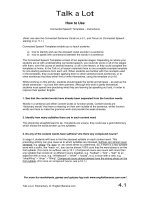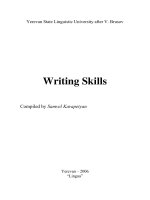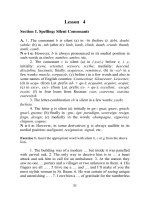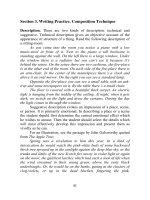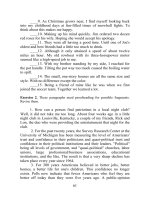Tài liệu Developing writting skills 2 part 6 docx
Bạn đang xem bản rút gọn của tài liệu. Xem và tải ngay bản đầy đủ của tài liệu tại đây (612.06 KB, 10 trang )
50
get the reader’s attention. Unless you get the reader’s attention, the
rest of the essay is wasted. Therefore, to write an interesting and
effective introduction, first it is important to write a few sentences
that draw the reader into the topic of your essay, and then present the
argument through a thesis statement that contains the topic and the
ideas to be developed.
There are a number of different ways to grab your reader’s
attention when writing an introductory paragraph.
1. You may want to tell a story. Stories are an interesting way
to appeal to the reader’s curiosity. They should be brief and
related to the main idea (the thesis statement). They can be
your personal stories or something you read or heard about.
2. You could start by describing a situation or an incident. The
reader can relate to situations or incidents that illustrate
clearly your point of view. They serve as examples and help
the reader recognize the problem more readily.
3. You might use facts and statistics. However, it is important
to use facts or statistics that startle the reader because he or
she does not expect this kind of information, and the facts or
statistics must be from a credible source.
4. You could ask one or more questions. You may want the
reader to think about possible answers or may want to
answer those questions yourself.
5. You may want to use quotations. This is another way to
attract your reader’s attention. Quoting someone famous,
using a proverb, a favorite expression or a slogan is
expressing your ideas through someone else’s voice.
6. You may challenge a widely held assumption or opinion or
you may open with a paradox (an apparent contradiction).
51
7. No matter which approach you take, make sure that your
introductory sentences are related to the thesis statement. It
is not a good idea to have a great gap between these two
parts. Therefore, having a transition sentence to connect the
two parts is very useful; it brings them close together. In
summary, an introduction prepares the reader for your essay,
it gets his/her attention, and it states the topic of your essay
and the direction it is going to take.
Supplementary Reading:
Hairston, M.: “Successful Writing”.
Meriwether, N.: “Writing Essays. Strategies for Success”.
52
TEXT 1
Why So Late ?
1. Are you often late for school or work?
2. Psychologists say that lateness is rarely an accident. More likely
it is connected to unconscious feelings about school or your job. You
may be bored, and lateness is your way of expressing your resistance
to wasting your time. Or, if you feel insecure because of poor
achievement, lateness is your way of saying “no” to an unhappy
situation. Then again, you may resent authority. You want to feel
free, unhampered by rules, regulations, bells, time clocks, and ID
cards. Any one of these could account for your tardiness.
3. There are as many alibis as there are explanations for chronic
lateness to school or to work. Professor Susan Shnidman of Harvard
Medical School has studied the problem for several years and in the
course of her work has heard some imaginative excuses for lateness:
“I took the garbage out. The door locked behind me. It took an hour
to find the superintendent to open the door.”
“My astrologer advised me not to get out of bed before noon today.”
“We wall-papered our living room last night and I couldn’t find the
front door.”
“My brother has the measles. I had to deliver his newspapers this
morning.”
53
4. Perhaps the most fanciful excuse Prof. Shnidman ever
uncovered was, “A snow flake flew into my watch and slowed down
the mechanism.”
5. In order to overcome frequent tardiness, psychologists advise
the following:
a) Be aware that it is an undesirable habit that may hurt those
you love.
b) Decide to change your ways.
c) Keep a daily log of your activities. Analyze it to see where
you could save time.
d) Divide your tasks into “must do” and “not necessary to do at
this time.”
e) Set your watch ahead. Trick yourself into being on time.
Explain what is meant by:
1. … if you feel insecure because of poor achievement, lateness
is your way of saying “no” to an unhappy situation.
2. You want to feel free, unhampered by rules, regulations,
bells, time clocks, and ID cards.
3. There are as many alibis as there are explanations for chronic
lateness to school or to work.
4. Keep a daily log of your activities.
QUESTIONS FOR STUDY AND DISCUSSION
1. Into how many parts can you divide the text? Why?
2. Is it effective to start an essay with a question?
3. How are paragraphs 2 and 3 connected?
4. Why do you think the author stresses/refers to the source he
has taken examples for illustration?
5. Which alibi was the most/least reasonable? What other alibis
can you think of as reasons or excuses for being late?
54
6. Do you agree with the psychologists who say that “lateness
is rarely an accident? More likely it is connected with
unconscious feeling about school or your job.”
7. Do you consider lateness an illness? If so, can it be cured?
How?
8. Do you agree with the psychologists’ pieces of advice to
overcome frequent tardiness? Which one, according to you,
is the best? How else can you advise people not to be late?
9. When was the last time you were late for an appointment?
What was the reason for it? Did you lie or tell the truth about
it? Why?
EXPAND YOUR VOCABULARY
Match the words in Column A with their definitions in Column B
A B
1) chronic a) not safe, unprotected
2) unhampered b) registration of facts in a
special notebook
3) insecure c) person who watches and
directs (work)
4) alibi d) infectious disease marked by
small red spots over the body
5) astrologer e) small, light, leaf-like piece
6) superintendent f) person studying the position
of stars
7) measles g) continual, lasting for a long
time
8) flake h) not aware of something
9) log i) a plea of having been
elsewhere
10) unconscious j) free to move or act

